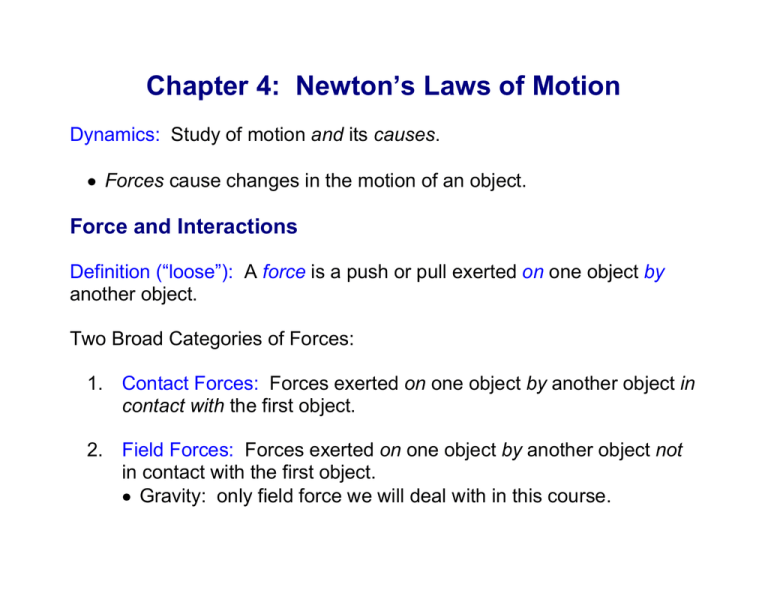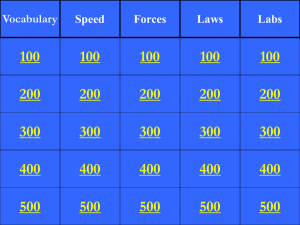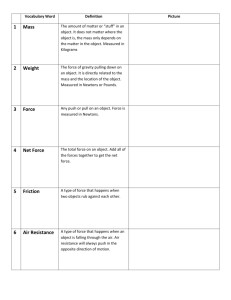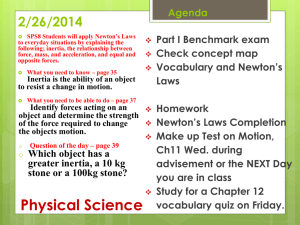Chapter 4: Newton’s Laws of Motion Force and Interactions
advertisement

Chapter 4: Newton’s Laws of Motion Dynamics: Study of motion and its causes. Forces cause changes in the motion of an object. Force and Interactions Definition (“loose”): A force is a push or pull exerted on one object by another object. Two Broad Categories of Forces: 1. Contact Forces: Forces exerted on one object by another object in contact with the first object. 2. Field Forces: Forces exerted on one object by another object not in contact with the first object. Gravity: only field force we will deal with in this course. Four Fundamental Forces: 1. Strong Nuclear Force Holds atomic nuclei together. 2. Electromagnetic Force “Electromagnetic” = “Electric” + “Magnetic” Responsible for electrical repulsion of like charges, attraction of unlike charges, e.g. 3. Weak Nuclear Force Responsible for “decay” of radioactive nuclei. 4. Gravitational Force Responsible for force of attraction between Earth and Moon, e.g. Which one of these fundamental ones are contact forces? Inertia and Mass Inertia: The tendency of an object to resist a change in its motion. Mass: A measure of the degree to which an object resists a change in its motion. (A measure of the “amount” of inertia an object possesses.) All objects resist a change in their motion to some degree. Newton’s Laws of Motion Sir Isaac Newton (1642-1727) First published in Philosophiae Naturalis Principia Mathematica, 1687 Newton’s First Law (“Law of Inertia”): An object acted upon by zero net force moves with constant velocity. “constant velocity” = constant speed in a constant direction (i.e., a straight line) If object was at rest to begin with, it will stay at rest; if it was moving to begin with, it will stay moving with same speed in same direction…. unless a net force acts on it. F 0 , then a 0 In symbols: If Net force = vector sum of all individual forces acting on the object: Fnet F F1 F2 FN (1) Newton’s Second Law: When a net force acts on an object (or a system of objects), the object (or system) accelerates with an acceleration that is directly proportional to the net external force and inversely proportional to the object’s mass: a F ma F m dv m dt (2) d r m 2 dt 2 (3) This one vector equation really implies three separate equations: Fx Fy Fz dvx m dt dv y m dt dvz m dt d 2x m 2 dt d2y m 2 dt d 2z m 2 dt (4) (5) (6) Notes: m 1. Unit for force (SI): kg 2 "Newton", N s 2. In F ma , the F , the m and the a all refer to a single object. So we need to be careful to isolate this object ”Free-Body Diagram” Free-Body Diagrams (FBDs) A proper FBD includes: 1. A sketch of the object whose motion you wish to analyze. Often, the object is represented simply by a dot. (There are good reasons for doing this which we will discuss later.) 2. All the forces acting on this object. No forces that this object exerts on other objects!! 3. Some kind of coordinate system (set of x and/or y axes). ...and not one single thing else!! General Procedure for Solving Most Newton’s Second Law Problems 1. Draw the FBD for the object whose motion you wish to analyze. 2. Resolve all forces into components. 3. Apply Newton’s 2nd Law separately to the x and y directions. That is, write down: Fill in Fx and Fx max Fy ma y Fy from your FBD. Fill in the mass, if known. Fill in a x and a y , if known. 4. Solve the resulting simultaneous equations for whatever you’re asked to find. You may have to use one or more “equations of constraint” to reduce the number of unknowns: constant acceleration constant acceleration equations of kinematics with “inextensible” strings (string does not stretch or go slack) Mass and Weight Not the same! But are related. Definition: The weight of an object is the net gravitational force on the object. Note: Weight is a force! Unit: N, not kg! To see how weight and mass related, just consider any object in free-fall. Newton’s 2nd law gives: Fy ma y w m( g ) w mg So the weight is the mass times the acceleration due to gravity. (7) Newton’s Third Law Whenever one object (Object #1) exerts a force on a second object (Object #2), Object #2 exerts a force on Object #1, and these two forces are equal in magnitude, opposite in direction. Symbolically, if we let F12 be the force that Object #1 exerts on #2 and F21 be the force that #2 exerts on #1, then 3rd law says: F21 F12 One of the forces in Newton’s 3rd law sometimes called the “action” force. The other is then the “reaction.” So 3rd law says forces always come in pairs! Note: The two forces in an action-reaction pair always act on different objects! So they don’t cancel! Tension Definition: The tension in a rope (string, cable, etc.) is the force that the rope exerts on the objects attached to the ends of the rope. The tension always pulls, never pushes! This fact follows directly from Newton’s 3rd law. Inertial Frames of Reference A frame of reference (coordinate system) in which Newton’s 1st law holds. st 1 law says: If F 0 , then a 0. Any accelerating frame is a noninertial frame. Consider person on roller skates in railroad boxcar that accelerates from rest, for example. As another example, consider bus rounding a curve.




